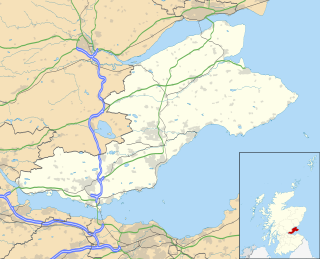
Dunfermline Abbey is a Church of Scotland parish church in Dunfermline, Fife, Scotland. The church occupies the site of the ancient chancel and transepts of a large medieval Benedictine abbey, which was confiscated and sacked in 1560 during the Scottish Reformation and permitted to fall into disrepair. Part of the old abbey church continued in use at that time and some parts of the abbey infrastructure still remain.

Fife is a council area, historic county, registration county and lieutenancy area of Scotland. It is situated between the Firth of Tay and the Firth of Forth, with inland boundaries with Perth and Kinross and Clackmannanshire. By custom it is widely held to have been one of the major Pictish kingdoms, known as Fib, and is still commonly known as the Kingdom of Fife within Scotland. A person from Fife is known as a Fifer. In older documents the county was very occasionally known by the anglicisation Fifeshire.

North Queensferry is a historic coastal village in Fife, Scotland, situated on the Firth of Forth, 9 mi (14 km) from Edinburgh city centre. Located on the North Queensferry Peninsula, it is the southernmost settlement in Fife.

Wemyss Castle is situated in Wemyss on the sea cliffs between the villages of East Wemyss and West Wemyss in Fife, Scotland. Wemyss Castle is considered to be a multi-period building, and today's castle includes many elements from former periods such as the 15th century tower and the 19th century stables and gatepiers.

Dunfermline is a city, parish, former Royal burgh in Fife, Scotland, 3 miles (5 km) from the northern shore of the Firth of Forth. Dunfermline was the de facto capital of the Kingdom of Scotland between the 11th and 15th centuries.

Saint Margaret of Scotland, also known as Margaret of Wessex, was Queen of Alba from 1070 to 1093 as the wife of King Malcolm III. Margaret was sometimes called "The Pearl of Scotland". She was a member of the House of Wessex and was born in the Kingdom of Hungary to the expatriate English prince Edward the Exile. She and her family returned to England in 1057. Following the death of Harold Godwinson at the Battle of Hastings in 1066, her brother Edgar Ætheling was elected as King of England but never crowned. After she and her family fled north, Margaret married Malcolm III of Scotland by the end of 1070.

Inverkeithing is a coastal town, parish and historic Royal burgh in Fife, Scotland, on the Firth of Forth, 9.5 miles northwest of Edinburgh city centre and 4 miles south of Dunfermline.

Dunfermline Palace is a ruined former Scottish royal palace and important tourist attraction in Dunfermline, Fife, Scotland. It is currently, along with other buildings of the adjacent Dunfermline Abbey, under the care of Historic Environment Scotland as a scheduled monument.

"Sir Patrick Spens" is one of the most popular of the Child Ballads, and is of Scottish origin. It is a maritime ballad about a disaster at sea.

Rossend Castle is a historic building in Burntisland, a town on the south coast of Fife, Scotland.

Elizabeth, Lady Wardlaw (1677–1727) was a Scottish poet and the reputed author of the ballad Hardyknute.
Ethelred was the son of King Malcolm III of Scotland and his wife Margaret of Wessex, the third oldest of the latter and the probable sixth oldest of the former. He took his name, almost certainly, from Margaret's great-grandfather Æthelred the Unready. He became the lay abbot of Dunkeld.

Pitreavie Castle is a country house, located between Rosyth and Dunfermline in Fife, Scotland. It was built in the early 17th century, and was extensively remodelled in 1885. The house remained in private hands until 1938, when it was acquired by the Air Ministry, and became RAF Pitreavie Castle. The RAF station closed in 1996, and the building was converted into residential apartments.

Dunfermline High School is one of four main high schools located in Dunfermline, Fife, Scotland. The school also caters for pupils from Kincardine, Rosyth and surrounding villages. The school was founded in 1468. Today it has over 1,550 pupils. The current Rector is Iain Yuile.
Dunfermline is a former burgh and current city in Fife, Scotland. The town grew under the influence of Queen Margaret to be an important ecclesiastical burgh. On 20 May 2022 it was granted city status.

Dunfermline City Chambers is a municipal facility at the corner of Bridge Street and Kirkgate in Dunfermline, Fife. The building, which serves as home to the local area committee of Fife Council, is a Category A listed building.

Pittencrieff Park is a public park in Dunfermline, Fife, Scotland. It was purchased in 1902 by Andrew Carnegie, and given to the people of Dunfermline in a ceremony the following year. Its lands include the historically significant and topologically rugged glen which interrupts the centre of Dunfermline and, accordingly, part of the intention of the purchase was to carry out civic development of the area in a way which also respected its heritage. The project notably attracted the attention of the urban planner and educationalist, Patrick Geddes.
Logie is a parish and village in east Fife, Scotland, 5 miles north-east of Cupar.















